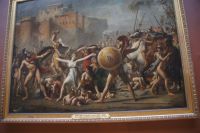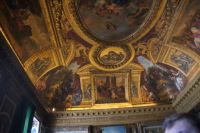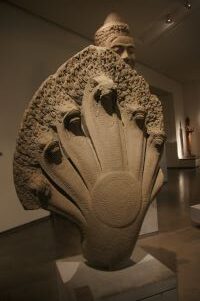There were a lot of tips today that we were in a world-class museum. Here are some that spring to mind:
– The line for admission goes half way around the block. That’s for those who were smart enough to reserve via the internet. The other line goes around the block and then some. Fortunately, our guide gave us a few tips; get there early and go to the nearby tobacco store that sells tickets. That was almost an oops, too. Ella and I got to the tobacco store in the Louvre Mall (you read that right) just as the mall opened (8:30) only to discover that we needed cash, and of course the first ATM machine was down. Happily, there were several others nearby, and so we were able to get the tickets, so that when students joined us at 9:45 we were able to go right in.
 – On your way to the 24 pictures/sculptures on the list you compiled of “must sees,” you spot one or two that are not on the list and a light bulb goes off, “Oh, THIS is where THAT is.”
– On your way to the 24 pictures/sculptures on the list you compiled of “must sees,” you spot one or two that are not on the list and a light bulb goes off, “Oh, THIS is where THAT is.”
– You are in to finding number 12 and three hours have already passed. Part of it is that the map is largely useless because some corridor is closed for renovation, and like most maps, it’s most useful for people who don’t need a map.
– You can tell where most of those 24 pictures are because the 8 million people visiting the Louvre today have chosen that time to get in front of you and dawdle while you’re trying to take the picture to prove that, yes, you did see the Mona Lisa (and realize it’s smaller than you thought, and not just because there are a hundred people between you and it)
– One of the twenty four pictures you had to see is on loan. If you want to see Delacroix’s Liberty, you’ll have to come back—or go the museum which currently houses it.
– Your feet start hurting and you realize it’s only four hours, and there are still ten pictures and sculptures left.
– In the case of the Louvre, you’re so dazzled by the art that you fail to  realize that you’re in one of the largest palaces in Europe, one that might have shamed even Versailles had it not been pillaged during the Revolution. As you sit down and pray for strength, you look up, and, by golly, there’s an enormous ceiling painting that some famous artist had painted just for the Bourbon family to see.
realize that you’re in one of the largest palaces in Europe, one that might have shamed even Versailles had it not been pillaged during the Revolution. As you sit down and pray for strength, you look up, and, by golly, there’s an enormous ceiling painting that some famous artist had painted just for the Bourbon family to see.
– You can spend as much time as you want in the bookstore, but no book will capture what you saw; most will be expensive, and all will weigh too much to take home with you.
– You are inevitably sidetracked by something you didn’t come to see—such as the wonderful Greek and Egyptian exhibits you did not know the Louvre had—that all of a sudden you realize time is fleeting and you have 8 other museums, possibly today, or else you’ll have to come back to Paris (not all bad!).
You are inevitably sidetracked by something you didn’t come to see—such as the wonderful Greek and Egyptian exhibits you did not know the Louvre had—that all of a sudden you realize time is fleeting and you have 8 other museums, possibly today, or else you’ll have to come back to Paris (not all bad!).
I think you get the picture, which is what you should do at an art museum. The building is a treat, having been the home of one of the richest kings in Europe at a time when monarchs could spend the country’s wealth on themselves (wasn’t it Louis XIV who declared, “I am the state?” ) and like the Bourbons, whose former palace became an art museum, the Romanovs in St. Petersburg saw (those who survived that revolution) their Winter Palace turned into an art museum—the Hermitage.
 Most of the traffic in the Louvre, not surprisingly, was in the European section, where it has a strong holding in pictures of and about the French Revolution (not the collection of the Bourbons!)—Ingres and David and Delacroix, for example, with the famous painting of Napoleon’s coronation ala Charlamagne, where I think he took the crown from the Pope and put it on his own head.
Most of the traffic in the Louvre, not surprisingly, was in the European section, where it has a strong holding in pictures of and about the French Revolution (not the collection of the Bourbons!)—Ingres and David and Delacroix, for example, with the famous painting of Napoleon’s coronation ala Charlamagne, where I think he took the crown from the Pope and put it on his own head.
People scattered in the afternoon, but there was at least one more museum I had to see, and while it doesn’t qualify as a “world-class” museum using the criteria I ascribed above, and I’m glad it didn’t have the tour buses in front, the Guimet museum should be on the list of every Asianist who comes to Paris.
The chief attraction for me is the “largest Cambodian art display outside of Cambodia.” Since Cambodia was part of French Indochina, and  the French were into archaeology, some of the artifacts “came from Cambodia” (imagine the passive voice—came on their own?) to this wonderful museum. A naga (snake, the protector of the Buddha) with a giant churning the sea of milk greets you; it used to be in Angkor Wat.
the French were into archaeology, some of the artifacts “came from Cambodia” (imagine the passive voice—came on their own?) to this wonderful museum. A naga (snake, the protector of the Buddha) with a giant churning the sea of milk greets you; it used to be in Angkor Wat.
The museum has an outstanding collection of other Southeast Asian countries’ artifacts, including India, Indonesia, the former French Indochina, Burma, Japan, and China. Having been to many of the places from which the art came to the Guimet, I could picture the statues in Pribanam or Borobudur in Indonesia, the Yungang caves in China (I was there last year), and so forth. The temporary exhibit was an outstanding collection of Bronze Age Chinese treasures—all the collection of one man. It was really worth my time.
I have to confess this is also an exciting city for foodies and for culture, and Professor Pana and I have been doing our best to savor both. Last night we wandered into a delightful arrondissement next to ours, Marais, with  narrow streets, local cafes, and nary a tourist/tour bus. We went to a concert in an Armenian Catholic church (Armenia was the first country to embrace Christianity) that seemed in need of the increased revenue brought in by a soprano and a pianist performing before a crowd equally divided between people who saw the concert was on a donation basis, and the duo’s friends from the conservatory. We stopped in a local bistro for dinner. Tonight we went with a few students to St. Chappelle, another Gothic Church near Notre Dame for another concert, one that is probably replicated in most European cities—with Pachelbel’s canon and Vivaldi’s Four Seasons. It was set in a church that might have had more stained glass (1113) than any church I have ever seen. Dinner was at a café—with Margret du Canard (look that up) as the main entrée.
narrow streets, local cafes, and nary a tourist/tour bus. We went to a concert in an Armenian Catholic church (Armenia was the first country to embrace Christianity) that seemed in need of the increased revenue brought in by a soprano and a pianist performing before a crowd equally divided between people who saw the concert was on a donation basis, and the duo’s friends from the conservatory. We stopped in a local bistro for dinner. Tonight we went with a few students to St. Chappelle, another Gothic Church near Notre Dame for another concert, one that is probably replicated in most European cities—with Pachelbel’s canon and Vivaldi’s Four Seasons. It was set in a church that might have had more stained glass (1113) than any church I have ever seen. Dinner was at a café—with Margret du Canard (look that up) as the main entrée.
There is only one Paris, and tomorrow has our business visits—and our last full day, unfortunately.